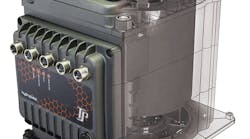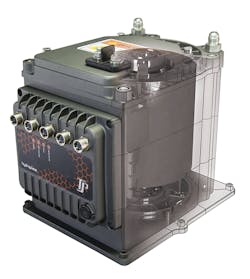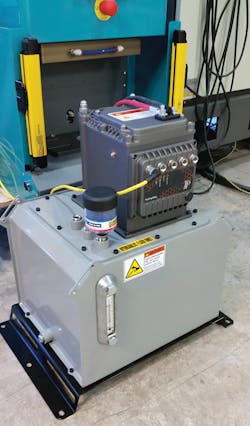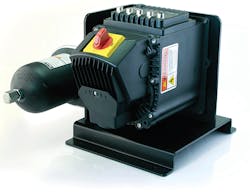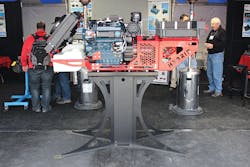This file type includes high resolution graphics and schematics when applicable.
Automotive engineers may be further ahead in applying hybrid technologies, but some of the most exciting hybrid innovations these days target off-road OEMs and makers of construction and farm equipment. Although these innovations could soon migrate over into consumer vehicles, right now they make sense for industrial vehicles and work equipment in terms of ROI and meeting (or avoiding) municipal and federal regulations.
Pressures for Hybrids
One set of factors pushing off-road OEMs and equipment manufacturers toward hybrids is the Environmental Protection Agency’s Tier 4 emission mandates on reducing diesel engine emissions. Designing and making engines that comply with the EPA rules have made those engines larger, heavier, and more costly. For example, Tier 4 standards substantially reduce the allowable level of nitrogen oxide emissions for engines above 75 hp (56 kW), further limit particulate emissions on diesels with more than 25 hp (19 kW), and put more stringent limits on hydrocarbons.
“Without a hybrid option, mobile OEM manufacturers can only say, ‘Yes, we’ve met Tier IV requirements,’ and then they have to live with the fact their machines are not only more expensive, but also less efficient,” said Mike Terzo, founder of Terzo Power Systems. “Plus, those OEMs need bigger engines to generate the same horsepower. Hybrids, on the other hand, offer substantial life-long savings in operating costs and reduced hydraulic oil and cooling demands, which lowers the vehicle’s weight for even more fuel savings.
“The minute you de-couple an internal combustion engine from directly driving the wheels and diesel engines in particular, you can match its performance with duty-cycle and cost,” he added. “You don't have to size for worst case because of an electric traction motor’s inherent benefits. They quickly deliver peak and rated torques, and peak and rated speeds, which internal combustion engines cannot do. Instead, internal combustion engines have to be over-designed.”
Terzo also argued that the hybrid supply chain is more efficient because it means shipping less oil and lowering the potential for spills—along with their associated costs and environmental impacts.
Another major factor in favor of hybrids for off-road working vehicles is that getting them from the garage to the work site is just the beginning. At that point, conventional drilling machines, aerial cranes, and back hoes have to run their diesel engines to power the equipment. The trucks also have to stay within any municipal or local regulations that determine how early in the morning they can start work, how long they can run their engines, and what time in the evening they have to stop.
Adding Electric Hybrid Technology to Hydraulics
One off-road hybrid concept comes from Terzo Power Systems and is being investigated by many off highway vehicle OEMs. It adds a smart hydraulic pump (the Hydrapulse pump) to the vehicle, and it can run off of battery power. The Hydrapulse incorporates Parker Hannifin’s high performance electric motor, the global vehicle motor (GVM), power electronics, and a Parker hydraulic pump—all in a compact package. The engine runs at a constant speed and powers a generator. The generator is sized to keep a battery pack fully charged when the vehicle travels under power from the engine. On the work site, the engine can be shut down and the battery will power the Hydrapulse pump, which can then operate the vehicle’s onboard work equipment—such as drills, cranes, and back hoes—without emissions.
The hydraulic pump is designed to re-use otherwise wasted energy, much like regenerative brakes do. So for example, after a front end loader scoops up dirt, raises it and dumps it, the energy from the lowering bucket pushes fluid backward through the smart pump and turns the GVM into a generator. The electricity goes to recharge the battery.
This hybrid approach creates a synergy between hydraulics, battery, and electric motor, yielding greater power density, lower emissions, smaller engine sizes, and the ability to better use each gallon of fuel.
The smart pump’s electric motor(s) can be either induction or permanent magnet AC (PMAC) types. The smart pumps can power some or all of the vehicle’s working hydraulics, as well as absorb kinetic energy and convert it to electric energy as the hydraulic systems decelerate.
Terzo said his firm chose Parker Hannifin's GVM as its hybrid system because “It is specifically designed for vehicle duty electrification and has been in production for many years.”
The GVM addresses efficiency and power density issues, and PMAC servomotors are the best compromise to meet the performance and efficiency requirements. The torque density and speed capabilities of PMAC motors, combined with a voltage-matched inverter, provide the speed and torque required in a variety of vehicle platforms.
“Typical efficiencies of PMAC motors, depending on windings, approach 97%,” Terzo said. “So with 10 kWh of battery life to spend, you lose only 3% to the motor.”
Depending on the type of vehicle that will use a particular version of this hybrid system, one or a series of “regenerative” (or bi-directional) motor controllers will be needed. An inverter sources its power from the DC bus and provides a variable frequency output to control the speed of the Hydrapulse’s elelectric motor(s) based on operator input.
In addition to the bi-directional inverter configuration, the vehicle will also need a dynamic braking circuit. In the event the drive cannot absorb or regenerate sufficient power for braking, a dynamic braking resistor is switched in to dump power. On some larger vehicles, more than one motor and inverter are employed for system redundancy. For off-road machines that rely on hydraulics to do the jobs they were designed for, the question becomes, “how do you run a hydraulic system cost-effectively off of a DC bus?”
“That's what our engineers spend a lot of time figuring out how to do,” Terzo said. “Before our product, engineers wanting to run hydraulics with electric energy would have to figure out inverters, communications protocol, high voltage safety, and dealing with high-voltage connectors and all that. Automotive companies know that stuff, but not many others outside that space.”
Future Off-Highway Electric Hybrids?
Recreational marine needs high levels of power, and hybrid technology could let watercraft rely on electric systems for extended periods. Replacing gas-powered engines with electric propulsion could let boats burn half the fuel and produce fewer emissions while running more quietly and efficiently. Running on batteries alone provides three hours of boating, and this climbs to 30 hr when they are supplemented with a small gas-powered auxiliary power unit.
Working boats, such as tugboats, must run their engines almost all the time to power the electrical devices onboard. But if equipped with a hybrid power system, there would be times when the engines could be shut off and there would still be electricity to run air conditioners, communication and navigation suites, or cranes. The main drive would also provide electrical power without a generator when the engines are running, which adds to the value proposition.
Hybrid systems can also improve small autonomous material handling vehicles. They combine the powertrain’s transport capabilities with the hydraulics that go into lifting and lowering crates and pallets. A lot of energy can be recaptured in these situations.
For example, in an aerial lift truck or “cherry picker,” a battery would operate the hydraulic lift mechanism for the boom, eliminating the need to leave the combustion engine idling while workers are on the lift. An inverter charges the battery (a 650-V lithium-ion array) while the engine runs and the battery powers an electric motor connected to a hydraulic pump when called upon. A clutch lets a single motor power the pump and double as a generator. In addition, the vehicle can be “plugged in” to charge the batteries when the vehicle is not in-use. This arrangement not only saves fuel but reduces noise—a requirement in some communities.
Ports could also benefit by switching to hybrid container handlers. Once their engines are off, they can unload containers from incoming vessels and load them on trailers. As for trucks waiting to carry the loads away, if they’re not hybrids they usually sit there idling. If drivers waiting to be loaded want air conditioning or to listen to the radio while waiting to be loaded, they’ll burn a gallon an hour. So whether a vehicle goes hundreds of miles, or just tens of miles in a shift, hybrid vehicles can make sense.
For many of these applications, a common concern will be battery cost and performance over time. Although advances in lithium ion batteries have made charge/discharge cycles better than they used to be, energy capacity still needs to be improved. A good electronic battery management system is also critical as it greatly influences battery life and performance.
Jay Schultz, Business Development Manager, Vehicle Electrification
Parker Hannifin Corp., Cleveland, Ohio
On and Off-Road Applications
A variety of practical hybrid systems are already in place in working vehicles equipment. Here’s a quick look:
Transit bus: A bus manufacturer combined a 250-hp main traction drive, a 60-hp generator (charging) inverter, and a 2-hp blower drive on a 40-ft. bus powered by an induction motor. In this case, “off the shelf” standard drives with CAN-Open communication cards were used. The major value is that the company avoided engineering expenses, as the drive was not custom made for the application. In addition, the short lead time reduced the need for the company to maintain inventory of hard-to-obtain or custom parts and eliminated the need to document a special system.
Express van: Standard Class 1 through 3 commercial vans have been converted to hybrid drive trains, increasing their efficiency while reducing fuel costs. Parker’s rugged MA3 motor controller and GVM motor contributed to the efficiency and road-worthiness. The hybrid drivetrain let a smaller internal combustion engine be specified without sacrificing performance or drivability.
Similarly, tugboats must run their engines almost all the time. But there are occasions where they can be shut off and the hybrid system can run air conditioners, electrical system, or cranes. The main drive engines provide electrical power without a generator, which adds to the value proposition.
This file type includes high resolution graphics and schematics when applicable.
